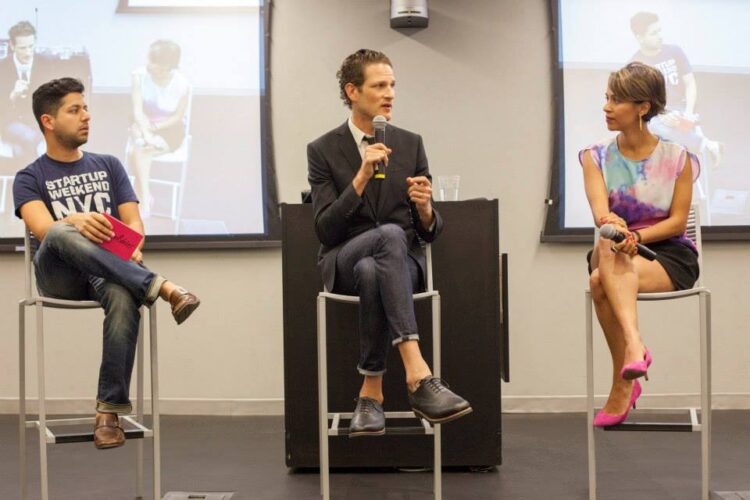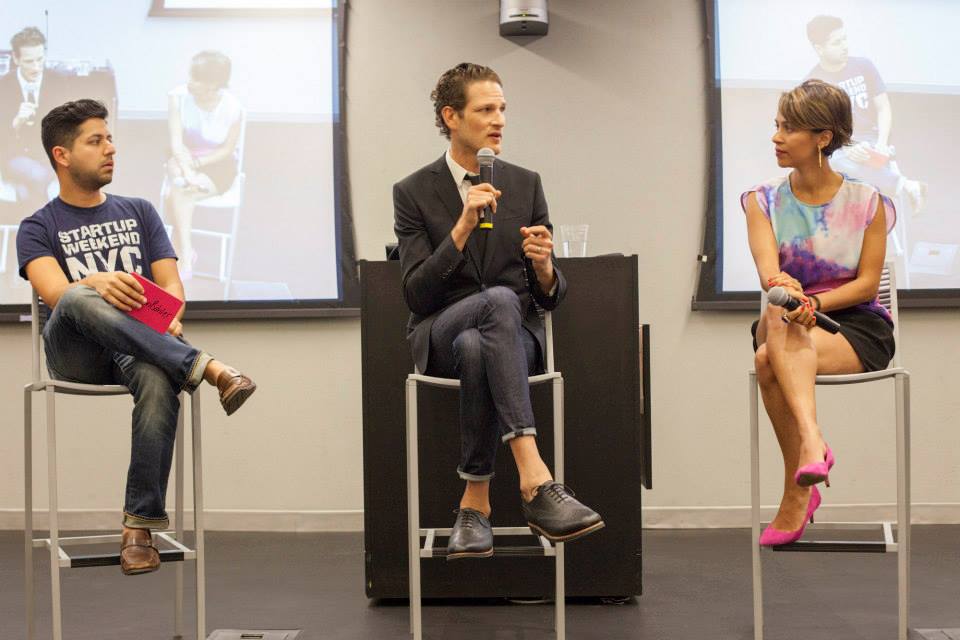Having worked with and coached hundreds of startups and entrepreneurs, Uri Minkoff (CEO of Rebecca Minkoff) and Liz Bacelar (Founder of Decoded Fashion) know from best practices when it comes to pitching. The panel shared a plethora of knowledge and advice for fashion tech startups at the Startup Weekend Fashion Tech Panel moderated by Pavan Bahl of OS Fashion. The event, which sold out in 36 hours and had a wait list of 800, was part of NYC Startup Weekend, which will be taking place on September 5th.
Minkoff dominated the evening with an extensive discussion about how and why his company chooses to work with specific startups, and was generous with strategic tips. As Minkoff is running a mostly cloud-based business (the first US retail stores are opening later this year),they have the luxury of being more agile, with no legacy footprint to worry about.
Both Bacelar and Minkoff have heard their fair share of pitches. “About 500 a year, 200 hundred of those are in person,” Bacelar disclosed. One of the biggest tips?
1. Timing. Although it may seem like common sense, make sure to know the industry’s workflow calendar, and approach them with your pitch during a down time. In the fashion industry, this means August and September are off limits, as companies are in full force prepping for and recovering from Fashion Week; instead get in touch during July or December. Choose pitch time wisely: you may only get one chance and best not ruin it just because the company was too busy.
2. Timing alone won’t close the deal; make sure to talk to the right person. Minkoff says the best way to ensure a win is to “find yourself an internal champion, and we will figure out a way to fund it.” If an indispensable person within the company tells the CEO she won’t work there unless they subscribe to a service, then they’ll figure out a way to get it. Find out who in the company can’t live without your service, approach them at the right time, and you could be set.
3. All of this doesn’t come without challenges however, with one of the biggest being that “there’s just so much noise,” Bacelar emphasized. What’s the best way to get yourself heard? “Find me at my trade show booth,” Minkoff advised. Make sure your two-minute pitch is down solid and get your face time in where you can.
4. But that’s not all – it’s not just about the pitch. The service has to be the right match for the company in terms of cost to value ratio (in addition to obviously being relevant). Minkoff was particularly passionate and verbose on this topic. Startups need to extensively analyze “the cost to value ratio of their service and make sure it’s appropriate,” he mentioned multiple times. “I’m more likely to spend $5,000 of my $25,000 budget on your service than all of my $25,000 budget to make sure my risk is spread out.” He emphasized that he’d be more likely to purchase a service that takes a smaller percentage of their allocated funds. If this isn’t the case within your pricing structure, then think like a salesman and offer early adopters a special price. “Once you get the first 2-4 companies to sign on, the next 20 will come easily,” so consider decreasing the profit margin to get some traction.
It’s key that everything falls into place just right. The cost benefit ratio and ensuring that you catch the right person at the right time contribute greatly to the ability to sell. Think you’ve got the next best fashion tech idea and have your 60 second pitch ready? Consider competing in the upcoming Startup Weekend Fashion & Tech NYC competition at LIM College.
Minkoff was even generous enough to share a genius idea he’s not seen executed yet: create a service that tracks duty and customs paid on products.
“If I pay duties and customs to bring bags into the US, then someone in Asia buys that bag online and pays duty and customs to have it shipped back, I should get a credit for that.” You’ve got 9 days till go time…get working.
Image credit: Spencer Kohn



